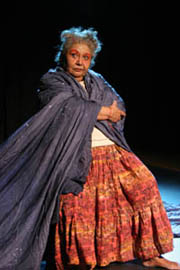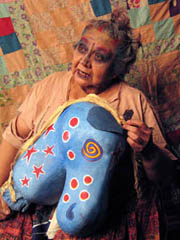|
|
 |
| Muriel Miguel in production shot from a laboratory production of "Red Mother" from The Heart of the City Festival in Vancouver in 2006. Photo by Tim Matheson. |
Q. How and why did you come to create
this new work?
A. Eight years ago, I was working in Canada at the Banff Centre.
We were doing a project about justice and using Brecht's plays as
a starting point for Native people to see how justice worked in
a Eurocentric way and to interpret the idea from a Native point
of view. I was doing "Mother Courage," and the director
was from the Berliner Ensemble in Germany. She had no idea about
Native people. I came in one day in this very bright skirt and she
said, "Oh that's too bright you can't wear that. This is war,
darling, this is war." I said, "Did you ever see an Indian
fight?" We paint everything. We paint our shirts, our vest,
our face, our horses. Afterwards I told people how discouraging
it was. People said, "You should do "Mother Courage"
from the point of view of an old Native lady." And I thought,
'Well, yeah.' It's been over 500 years, and we're still talking
about racism and how Native people feel and how we're regarded.
I started to put one thing upon the other, layer it in my way of
thinking about it.
Q. Can you describe this storyweaving
technique?
A. You have to understand stories and the passing on in the Native
oral tradition. The first circle is the circle where, as a young
child, you hear stories from under the kitchen table; how Uncle
Joe met Aunt Lizzie or what scandals happened in the family. Those
stories connect the next circle of immediate people outside of your
family. That's where many of the creation stories are; stories of
how did a tribe happen, how did that nation happen, how did the
robin breast turn red. The third circle is how that whole group
of people interact with another group of people. For instance, another
nation. And then how does all these tribes interconnect and interact
with the next circle. The last circle is how do we, as Native people,
see the world, that outside circle, and how does the world see us.
There are so many circles, so many ripples and it's so layered.
When we talk about storyweaving, we're talking about a really thick
tapestry of stories and how one thing affects another thing.
 |
| Muriel Miguel takes stage with a painted face in "Red Mother." A gigantic quilt forms the play's backdrop. |
Q. Can you describe what "Red Mother"
is about in your own words?
A. I started by thinking about women are on the fringe and who are
not considered heroes: prostitutes, addicts, drunks. Even women
like that passed something onto us. Otherwise, a lot of people wouldn't
know who they were. That's a strong part of us. I also started thinking
about the demon stories of the Kuna. Demon stories were used to
keep kids in line and always have a lesson in them. They're passed
down orally. The medicine people, the chiefs, sit in hammocks and
they tell the stories. It was layered into wanting to do a "Mother
Courage" my own way, as I see it. Thinking of the Indian wars
and the massacres and the battles, it's overwhelming. How do you
layer in all the sounds of these different nations and different
chiefs? I started to collect all those names to give our scrolling
of the wall of the dead like Vietnam and the Holocaust and even
9/11. I wanted to honor all of this history from the point of view
of a Native person.
Q. What's it like being directed by your
daughter?
A. It's fun. We run on the same idea, and we have the same values
in theater. She's bossy and a bully and so am I. When she comes
up with crazy ideas, I just go with it and see where it leads.
Q. What or who is inspiring you right
now?
A. I'm tired of reacting. I want to do positive work. I want a Native
theater space. In NYC, the Native people are quite vocal! Native
people here have to be active. We need a theater space that's ours
that we own, that's what's inspiring me now.
| museums | NYTW mail | recordings | coupons | publications | classified |

